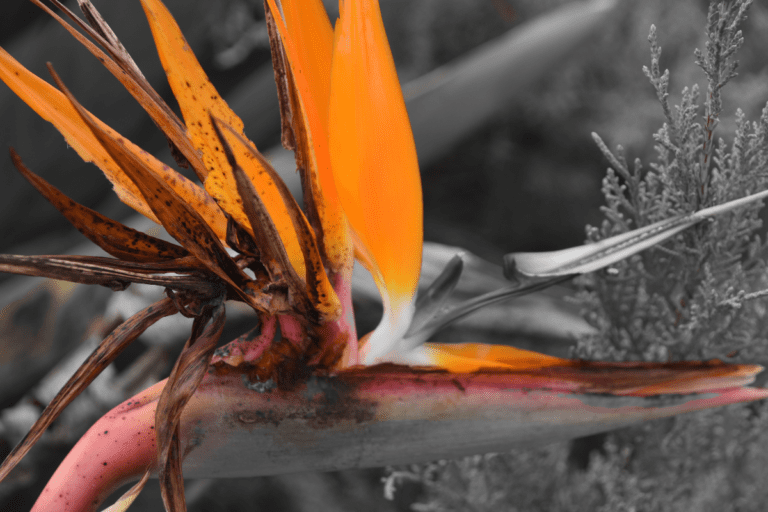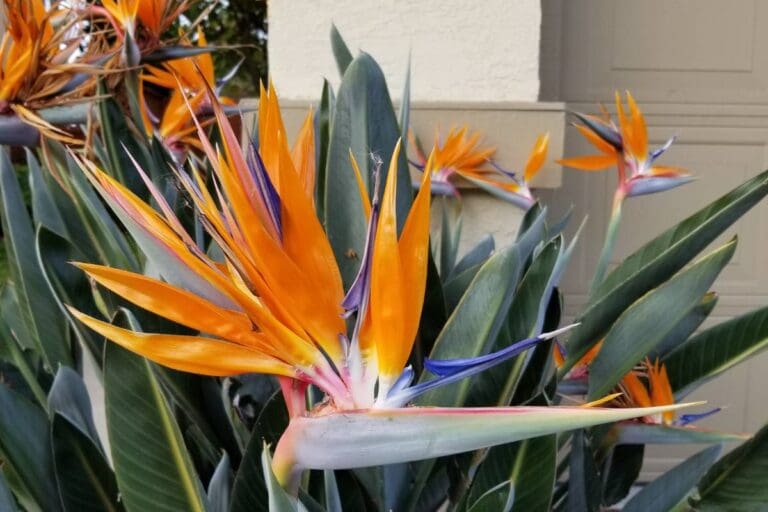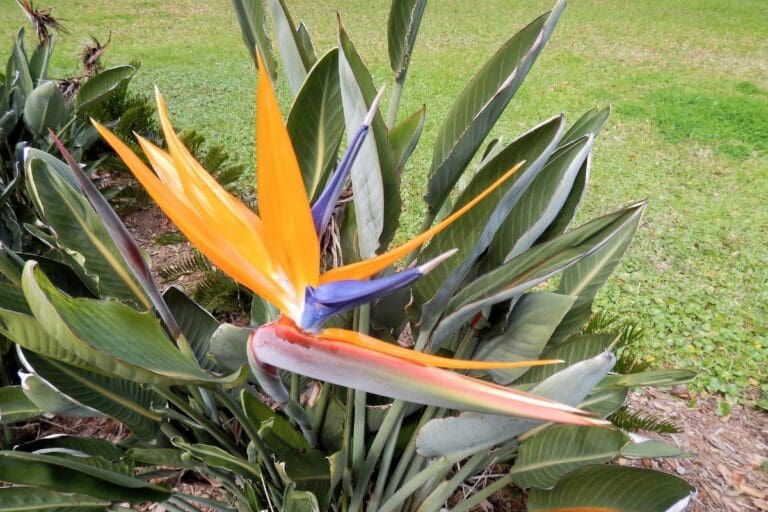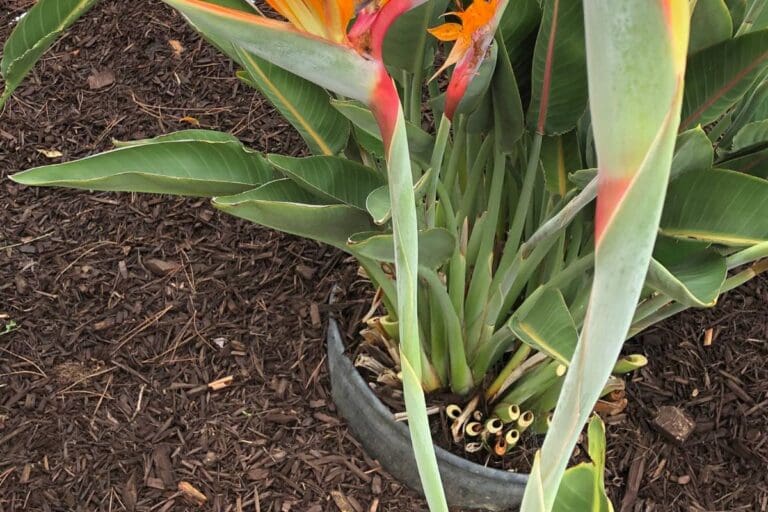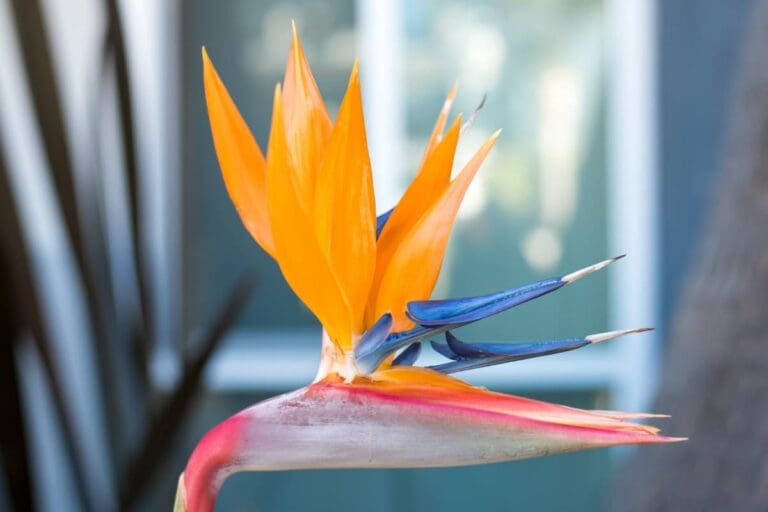Why Is My Bird of Paradise Leaves Splitting? (8 Causes+Fix)
Bird of paradise is primarily famous for its vast and beautiful foliage. So, I know how badly it hurts to see those gorgeous leaves splitting. Generally, the splitting of leaves is quite common in birds of paradise. So, there is no need to worry as it hardly causes any harm to the plant.
If the leaves are splitting more frequently than usual, it can be due to a lack of humidity, improper watering, nutrient deficiencies, pest problems, incorrect lighting, wind damage, and mishandling. Proper care can help you prevent splitting your bird of paradise leaves.
In this article, I will help you address all the possible causes of leaves splitting along with the solutions.

Please note: Simplify Plants is reader-supported. Some links in the post are affiliate links and I get a commission from purchases made through links in the post.
Causes of splitting leaves in bird of paradise plants
8 causes can cause the splitting of leaves in the bird of paradise plant.
Let’s discuss each of them in detail.
1. Aging
If you have a bird of paradise in your home, it’s normal to see the leaves splitting because of aging.
It happens because the cells inside the leaves start to age.
If you notice the plant is not showing any other symptoms like yellowing, browning, and wilting of leaves, then aging is likely to be the cause.
It is a natural thing. So, there is nothing to worry about.
Simply get rid of the older foliage.
2. Overwatering and underwatering issues
Both conditions can cause leaves to split in the bird of paradise plant.
But how? Let’s discuss this.
Overwatering
Watering the soil blindly without checking the soil’s moisture level can make your bird of paradise suffer from overwatering.
When the soil remains in the water for a prolonged period, it doesn’t allow oxygen to pass inside the soil, damaging the root system.
Due to this, the plant enters a shock, affecting the entire health system and causing the splitting of leaves.
But how to identify if this is the cause?
You will notice soggy soil, mushy, brown, yellow, wilted leaves, and a rotten smell from the soil.
Underwatering

When a bird of paradise doesn’t get sufficient water, the roots fail to pass moisture and nutrients among different parts of the plant, causing dehydration.
Due to a lack of moisture on the leaves, they become dehydrated and begin to split.
To find the cause, look for dry, wrinkled, droopy, and yellowing leaves.
3. Nutrients deficiencies
Nutrient deficiency is one of the leading causes of why your bird of paradise leaves splitting.
Bird of paradise needs a proper amount of nutrients to thrive.
Splitting of leaves mainly occurs due to a lack of 4 nutrients, i.e., Nitrogen, calcium, boron, and magnesium.
| Nutrient type | Importance and its effects |
|---|---|
| 1. Nitrogen | Nitrogen supports new and green growth in the plant. A deficiency of this nutrient can weaken the leaves, so it starts splitting after some time. |
| 2. Boron | Boron helps in synthesizing the cell walls, creating new plant cells. Due to a boron deficiency, the cell doesn’t develop in the leaves, causing them to split. |
| 3. Magnesium | Magnesium helps activate the plant enzymes required for growth by increasing chlorophyll production. Lack of magnesium makes the plant weak, causing the splitting of leaves. |
| 4. Calcium | Similarly, just like boron, calcium also helps to create new cells, which is necessary for the growth and development of plants. Calcium deficiency primarily affects younger leaves, causing them to be torn and turn black. |
4. Damage from the wind
If you place your bird of paradise near a window or door, the plant can easily suffer from wind damage.
Not only can it tear the foliage, but it can also break the stems of the plant, causing extreme harm.
Now, how can those thick leaves split just because of the wind?
This happens because of the water content inside the foliage.
For example, if the right side of the foliage has more water content (65%) than the left side (35%), the veins can no longer hold the pressure on one side, causing the leaves to split.
High air pressure from the fans can also cause the leaves to split.
5. Too much light

Exposing the bird of paradise to excessive sunlight can also cause leaves to split. How?
When a bird of paradise plant receives excessive sunlight, then the plant starts to lose moisture from every part due to an increased evaporation rate.
This causes the leaves to dry out completely, increasing the chances of splitting.
6. Low humidity
The leaves are coated with a tissue which is known as a sheath.
Due to low humidity, the surrounding becomes extremely dry, causing the tissue of the leaves to become thinner, which increases the chances of splitting.
Bird of paradise thrives in humidity ranging between 60-70%.
This highly humid climate protects the tissue from getting thinner and weaker.
7. Mishandling
Sometimes, you can cause harm to your bird of paradise even if you don’t want it.
It mainly happens while:
- Knocking over the plant while placing it in a new location.
- If you have placed the plant above the tool, table, or stand.
- Kept the plant where the pets and children can reach it easily.
- Placed the plant beside a standing fan or frequently open and close doors or windows.
These are the most common mistake most houseplant owners make, which causes the leaves to split.
Even I have made this mistake, especially the pet one.
So, check whether you are making any mistakes and treat them accordingly.
8. Pests attack

Here we come with the last and most dangerous cause of the splitting of leaves.
So what happens if the pests attack the bird of paradise?
They suck out all the nutrients in sap from the stems and leaves, leaving the plant ultimately fragile.
Pests tear the tissue of the leaves by feeding on them, causing the splitting of leaves.
The most common pests that can attack birds of paradise are mealybugs, spider mites, aphids, scales, and white flies.
They all affect the plant similarly by feeding on the sap.
Prevention and treatment of splitting leaves in bird of paradise plant
Now, let’s discuss how you will treat the plant according to its causes.
First, you must prune all the damaged leaves to recover your bird of paradise.
Now let’s begin:
1. Treating watering issues
Let’s discuss both solutions separately:
Overwatering
Repotting is the best solution if your bird of paradise is suffering from overwatering.
Take a pot 2 to 3 inches larger than the old one and prepare a well-draining potting soil.
Then, repot the bird of paradise in the new container by eliminating all the damaged roots.
After repotting, place your bird of paradise near bright indirect sunlight and avoid watering until the plant recovers from the damage.
Underwatering
Start watering the bird of paradise until you see the water draining from the drainage holes.
But always take a gap while watering.
Don’t pressurize the plant by providing water all of a sudden.
The plant always takes time to adjust.
If, by any chance, your bird of paradise is getting direct light, relocate it to a place where it will receive indirect light.
Before watering, checking the soil’s moisture with a moisture meter device or finger method will help prevent watering issues.
2. Treating excessive light

Immediately change the location where the bird of paradise will get indirect light, but not too direct.
Provide sheer curtains to reduce the intensity if the plant is still getting intense direct light.
I always keep my houseplants 5 feet away from the windows.
You can also do this.
Maintaining a cool temperature, keeping the plant hydrated, and shielding the plant with shade will help you prevent this problem.
3. Treating low humidity
I know 5 methods for increasing the humidity around your plant.
Let’s discuss each of them, and you can apply them at your convenience.
- Misting: Take a spray bottle filled with water and mist the entire plant. This method increases the humidity temporarily.
- Pebble tray method: Take a tray, fill it with water and pebbles, and place the plant on it. The humidity will automatically increase due to evaporation.
- Water bowls: Take 3-4 bowls filled with water and keep them around your bird of paradise to increase humidity.
- Houseplants: Keep your bird of paradise around moisture-loving houseplants. As soon as you water the plants, the humidity will increase.
- Humidifier: You can simply purchase a humidifier device to increase the humidity. This is the most convenient way.
Purchase a hygrometer for frequently checking the humidity level around your plant to prevent low humidity problems.
4. Treating wind damage
If you don’t want your bird of paradise to suffer from wind damage, the only option is to change the location.
Keep the plant away from a window or door and place it somewhere safe.
Also, don’t ever place the plant outdoors during the windy climate.
Even if you are, immediately bring it inside.
Also, don’t place the bird of paradise near a standing fan.
I keep my houseplants mainly in the corners as it’s the best possible location.
Checking for the windy climate every day will help you prevent this issue.
5. Treating nutrient deficiencies

Remember we talked about 4 nutrient deficiencies that can cause the splitting of leaves?
Now, let’s discuss each of the solutions separately.
- Nitrogen: Coffee grounds, banana peels, eggshells, grass clippings, and fish emulsion can help you to increase Nitrogen in the soil. You can also simply use a nitrogen-rich fertilizer directly in the soil.
- Boron: Mix one tablespoon of boric acid with one-gallon water. Then spray on the leaves. Avoid applying the solution to the soil.
- Magnesium: Take one tablespoon of Epsom salt, dilute it with one gallon of water, and apply it to the soil.
- Calcium: Provide lime or crushed eggshells to increase calcium in the soil.
Frequently testing the soil to check the soil’s pH level can help you identify the requirement of nutrients.
This can prevent nutrient deficiencies in your bird of paradise.
6. Treating pests
The first step is to prune the damaged parts and isolate the bird of paradise far away from other houseplants.
Then wear gloves and pick up all the visible pests with your hands.
After that shower, your plant with water to wash away all the pests.
If the pests are still stuck on your plant, take wet cotton balls and wipe them off.
Make sure to dip it in rubbing alcohol.
Provide a biological pesticide all over the plant to avoid further infestations.
Spraying the plant with pesticides every 2 to 3 weeks with pruning can help you prevent this problem.
7. Overcoming physical damage
If you don’t want your bird of paradise to face any physical damage, then follow the steps given below:
- Select a location where children and pets will not be able to reach. For example, higher on the shelves, balcony, or hanging baskets.
- Make sure to keep the pets in different rooms while leaving the house.
- If the bird of paradise is kept near an overcrowded environment, try to provide a space for it.
- Don’t keep the plant near a frequent open and close window or a standing fan. The air pressure can tear the leaves.
- If you are keeping your plant on a stand, immediately change the location to somewhere safe.
- Avoid keeping the plant near a bookshelf; otherwise, anyone can knock your plant easily.
- To avoid physical damage, advice everyone in your house not to touch or throw objects at your bird of paradise.
Pruning and trimming techniques for split leaves
Tools you will require for pruning are:
- Safety gloves
- Disinfected pruners or hand-pruning saw
- Rubbing alcohol
How to prune?
- Sterilize the tools with rubbing alcohol first.
- Check how many leaves are damaged. In case of multiple splitting of leaves, select only a few for pruning to avoid stress.
- Grab your pruner and trim the base of the stem where the leaf is attached. Try to give a clean cut always.
- Then, apply a cinnamon paste or powder to the cut. This will avoid infection.
- Throw all the trimmed parts and stems. Also, wash the pruners properly.
- After pruning, provide proper care to your bird of paradise without ignoring the basic needs to avoid any stress.
Signs that your bird of paradise is recovering from splitting leaves

The signs that your bird of paradise is recovering from the splitting of leaves are:
- You will notice new growth of stems and leaves.
- There will be no signs of yellowing and browning leaves.
- You will not get any rotten smell from the soil.
- You will notice thick and green foliage with no wrinkled or droopy texture.
Maintaining a healthy bird of paradise plant
You should remember a few things to maintain a healthy bird of paradise.
| Factor | Care requirements |
|---|---|
| Water | Before watering, always check the top 2 to 3 inches of soil. If it’s dry, only water your plant; otherwise, don’t. |
| Sunlight | Provide bright indirect sunlight to your bird of paradise. Also, give shade if the light is intense. |
| Fertilizer | Apply a well-balanced liquid fertilizer every month to your bird of paradise to avoid nutrient deficiencies. |
| Humidity | Try to maintain a humid environment for a bird of paradise. Frequently check the surrounding with the help of a hygrometer. |
| Pruning | If you notice damaged parts, prune them immediately to encourage new growth. |
| Location | Always place your bird of paradise in a well-ventilated location. |
| Drainage | Maintain good draining soil and proper drainage holes on the pot. |
| Repotting | Always re-pot the bird of paradise whenever it is required, especially in the case of root-bound and root rot disease. You usually should repot it every 18 to 24 months. |
Final words
There is no need to worry if your bird of paradise leaves are splitting. It is entirely normal in most cases.
When I saw one of my houseplant’s leaves splitting, I immediately found the exact cause and treated it as quickly as possible. So, if you think treating your plant is difficult, then you’re wrong.
Identifying and recovering the splitting of leaves in the bird of paradise is easy. So, stay calm and treat your plant correctly.
Is it normal to see a bird of paradise’s leaves splitting?
Yes, it is typical to see your bird of paradise splitting. These plants split naturally to pass the wind between the leaves. So, in most cases, there is no need to worry about seeing your plant’s leaves splitting.
How much time does it take to recover the plant from splitting leaves?
It will take approximately 2-4 weeks to recover your plant entirely from the splitting of leaves, depending on the amount of damage.
Is it possible to repair split leaves?
Well, it is possible to repair split leaves only if they are mild. You will need candle wax or beeswax for repair. Then, make a paste, put it on the torn area, and brush it gently. After some time, the wax will automatically come out, and the leaves will look just like before.
Reference: Wikipedia
Recommended Garden Supplies
| Product Image | Our Recommended Gardening Supplies | Check Offers! |
|---|---|---|
Top Top
Top
Top
Top
Top
Top
Top
Top | rePotme Houseplant and Tropical Classic Potting Soil Mix | Check Offer On Amazon |
 Top
Top
Top
Top
Top
Top
Top
Top | Espoma Organic Indoor Plant Food | Check Offer On Amazon |
 Top
Top
Top
Top
Top
Top
Top
Top | GooingTop LED Grow Light 6000K Full Spectrum Clip Plant Growing Lamp | Check Offer On Amazon |
 Top
Top
Top
Top
Top
Top
Top
Top | Soil Moisture Meter | Check Offer On Amazon |
 Top
Top
Top
Top
Top
Top
Top
Top | Govee Hygrometer Thermometer, Bluetooth Enabled! | Check Offer On Amazon |
 Top
Top | LEVOIT Humidifiers for Large Room(Best For Plants) | Check Offer On Amazon |
 Top
Top
Top
Top
Top
Top
Top
Top | Upgraded DIY Automatic Drip Irrigation Kit, 15 Potted Houseplants Support | Check Offer On Amazon |
 Top
Top
Top
Top
Top
Top
Top
Top | Stainless Steel Heavy Duty Gardening Tool Set | Check Offer On Amazon |
 Top
Top
Top
Top
Top
Top
Top
Top | Bonide Insecticidal Soap | Check Offer On Amazon |
 Top
Top
Top
Top
Top
Top
Top
Top | Bonide 32 oz Spray Neem Oil for Organic Gardening | Check Offer On Amazon |
 Top
Top
Top
Top
Top
Top
Top
Top | Garden Safe Fungicide | Check Offer On Amazon |

